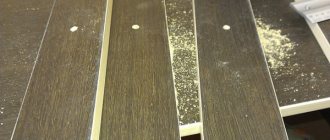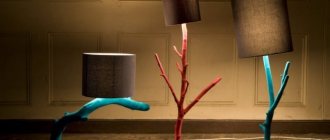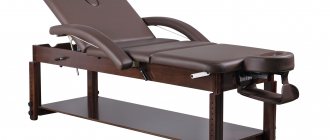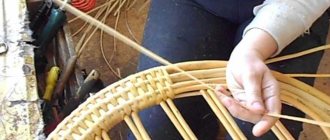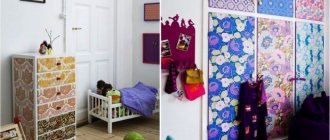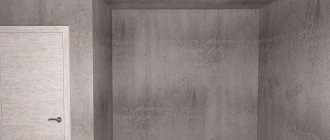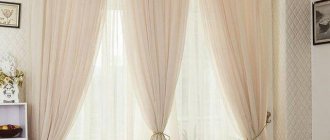Does a newborn baby need a changing table? What are they? How to make a diaper changer with your own hands?
The list of dowry for the baby, which parents must prepare even before his birth, is very extensive. It includes a stroller, a crib with a bed, a bath, clothes, children's cosmetics and a first aid kit, so to speak, the essentials. Sometimes this list also includes a changing table. Is it needed? Is it convenient? Is it possible to make it with your own hands?
Do you need a changing table or chest of drawers?
Some couples, most often those who are going to become parents for the first time, consider a changing table a luxury, a pampering, and not at all a necessity. Like, if you have extra money, why not spend it?
Others are experiencing a shortage of living space; it seems to them that there is simply nowhere to fit such a piece of furniture in a one-room apartment. They would like a diaper changer, but cannot afford one.
And the thing, by the way, is very convenient!
The changing table is safe for the baby and convenient for the mother.
- It provides convenience for mom. The baby has to change clothes a certain number of times a day - for a walk, from a walk, again for a walk and from a walk, at night. That's not counting the endless diaper changes, food stains or spit-up items. If we assume how many times and for how long mom needs to spend bent over the sofa, for example, her poor back! But they often suffer during pregnancy and childbirth. The diaper is located at such a level that the mother does not have to bend
- It will ensure safety for the baby. If it is a changing table or chest of drawers, as a rule, the space under the changing table is allocated for baby cosmetics, diapers, and wet wipes. You can remove them with one hand and hold the baby with the other. After all, after four months, when he learns to roll over and then crawl, the risk of falling from a sofa or a regular table increases in that single second for which the parent leaves to take something necessary for a hygiene procedure or changing clothes
- It will become a place for massage and gymnastics. Massage and gymnastics, therapeutic or restorative, are required for a baby up to one year old. Doctors insist that they be performed on a hard, level surface. The sofa, as an option, disappears immediately. But the diaper changer is just the thing
- On the changing table it will be convenient for the doctor to examine the baby. In the first year of life, the staff of the children's clinic will periodically visit the baby
Obviously, a diaper changer would be nice to have. But in stores the prices for it are off the charts: changing tables and chests of drawers sometimes cost twice or three times more than usual! There is no need to be upset, you need to be enterprising and try to make a piece of furniture with your own hands!
Materials for changing chest
Changing chests of drawers are modular furniture, the implementation of which is within the capabilities of a man who knows how to draw and hold a drill. Making it yourself has a number of advantages.
Individual sizes (especially important for small apartments), budget savings, creating unique things for your child.
DIY pelenator made of laminated chipboard
It is preferable to use wood, as it is rightfully classified as an eco-friendly material. But the cost of natural wood is quite high, and working with it is very labor-intensive. Chipboard and MDF laminated boards are an excellent alternative. Before purchasing materials for a children's room, be sure to check the quality certificates. This applies to any material.
Up to what age do you need a changing table?
Manufacturers of changing tables write in the instructions that they are intended for children up to twelve months. But in practice, parents describe some discrepancies:
- There are diapers with a length of only 70 cm. These cease to be comfortable for babies aged 6-9 months
- If the length of the diaper is 90 or 100 cm, it can also be used for a child older than one year who still wears diapers and does not know how to change clothes himself
The changing table is intended for children from birth to one year.
How to assemble a changing table at home: tips and reviews
Alexandra : Our first parenthood coincided with the end of our studies. It’s not worth explaining that there was no money for anything, and the parents took a principled position - you are an independent family, and we will not give you help. And after consulting with my husband, we decided to make all the children’s furniture ourselves to make it cheaper. The pelenator was made hanging from an IKEA photo, drawings and calculations were done ourselves. Our third baby is already growing on it, we don’t even think about buying furniture. Something made with your own hands is especially expensive, much more reliable, and it makes your soul feel good when you look at things made with your own hands.
Ulyana : We have been planning the baby for a very long time. So long that during this time they managed to settle into their apartment, dacha and car. But here is a holiday on our street - two stripes on the dough. Probably the kid was just waiting for his parents to earn everything for his good life. Pregnancy is the time to create a mini world for our baby. We opened the catalogs and were upset, what we really like is somewhere in Europe, but here everything is so formulaic. But our budget does not allow us to shop in expensive European stores, or even pay for delivery from distant lands. That evening we shared our experiences with friends who gave us the idea. Individual solution! My husband was so excited that he decided to do everything himself. His first product is a changing chest of drawers. We already have standard drawings plus a fairy-tale fantasy and a Cinderella-style chest of drawers with a crown diaper.
Types of changing tables: photo
Before you make a drawing of a baby diaper, prepare the necessary materials and tools, and actually start making the structure, you need to decide what it will be like.
- The simplest option is this soft changing board, which can be installed on a regular chest of drawers, a table, placed on a sofa, carried and transported. As a rule, it is soft, covered with waterproof material on top. The sides on the sides of the board ensure the safety of the baby
- The next type of diaper changer is a whatnot. A wooden, metal or plastic frame is complemented by several drawers or shelves, as well as a hard or soft changing board
- An even more convenient option is a chest of drawers with a changing station. The children's chest of drawers is roomy, wide and stable. Most often, this is an ordinary children's chest of drawers, equipped with a removable changing area. The advantage of a chest of drawers is that it will last much more than a year. Disadvantage: it requires a lot of space
- The hanging diaper is a very ergonomic design. Usually, it is attached to the wall and reclines as needed. It is equipped with pockets for storing children's things.
- It is not easy to make a transformer diaper yourself, but it is possible. It would be great if it could later be turned into a children’s desk, at which a child from one year old will play and create.
Changing board.
Changing table - whatnot.
Hanging and folding changing table.
Pelenator - chest of drawers.
Step-by-step instruction
When planning the assembly of the classic and most functional model of a changing table, namely a chest of drawers with internal drawers and a hinged lid (removable if desired), work begins with drawing up a diagram, selecting and calculating materials, preparing tools and premises. The process itself is divided into separate stages:
- Marking and cutting of workpieces.
- Processing of edges and surfaces. Unlike ordinary chests of drawers, such products have a minimum of protruding corners; their sides are necessarily rounded.
- Sequential assembly of the frame, drawers, fastening of guides and the table itself.
- Preparation of the mattress, decoration.
Tips for making a computer desk with your own hands, stages of work.
In the classic version, the chest of drawers is equipped with ordinary drawers (2 in the top row + 2 or 3 common bottom ones), but there are no restrictions. The general requirements include only the need for a higher back wall and a protrusion of the sides up by 10 cm. When assembled, the folding part of the changing table must be closed.
Marking and cutting blanks
Edge processing and corner rounding
Assembling the frame and fastening the guides
Assembling the box
Installing drawers in a chest of drawers
Preparing the mattress
Create a drawing
Ready-made drawings of changing tables for newborns are freely available on various online resources. In the absence of experience in carpentry work, it is not recommended to deviate from the dimensions indicated in them. If you need to make adjustments or design your own model, programs like PRO100, Astra, Basis-Furniture Maker, WOODY are a good help. These same services help calculate the required amount of material and draw up a cutting plan for sheet plates.
The height of the chest of drawers remains standard, the main level is maintained within the range of 80–110 cm. The depth is selected taking into account the height of the child; when unfolded, the length of the changing pad should be at least 70 cm (optimally 90–100 cm). The width of the chest of drawers can be any, but models in the range from 80 to 100 cm are considered the most comfortable.
Preparation of materials
A jigsaw is best suited for cutting blanks for a changing table. If you are confident in the sketch, slab materials can be cut in the warehouse at the time of purchase. Mandatory requirements of the technology include rounding the edges of individual parts, treating open areas with sealing and antiseptic compounds, followed by covering with tape.
Taking into account the rounding of the parts, it is difficult to calculate the exact length of the tape, so it is recommended to purchase it with a small margin.
The preparation stage ends with drilling holes for fasteners, after mandatory checking of the markings. In addition, the locations of corners, intersection ties, guides or confirmations are marked on the blanks with a pencil. All necessary points on the sides or edges must “mirror” each other; deviations from a single level of more than 1 mm are not allowed.
Lay out the workpieces, make markings according to the drawing and drill holes for fasteners
Frame
The finished parts are assembled into a single structure using a screwdriver or hex key. The table assembly procedure is standard:
- The chest of drawers is assembled sequentially. At this stage, the bottom, sides (if there are separate elements), and the back wall are screwed to the sidewalls with fixed guides.
- Using confirmations, the internal shelves are fixed.
- The boxes are assembled separately and the evenness of each is checked. The second part of the guides is fixed on the outer sides of the drawers along pre-marked lines.
- The smooth movement of the drawers is checked, and if there are no problems, the fittings are fixed on the facades.
Regardless of the method of arrangement of the internal shelves, at each stage of assembly, using a square and a building level, the evenness of the structure is checked.
Install the guides on the side walls of the chest of drawers
Sequentially assemble the product box
Collect boxes
Fix the fittings
Table installation
The folding table is assembled and mounted last. Maximum reliability of fastening the horizontal part and sides is provided by ordinary metal corners. Installation is completed by tightening the double-sided bolts, which are finally tightened after checking the stability, evenness and smooth tilting of the shelf-lid.
Tips for making a welding table with your own hands, work procedure
To avoid mistakes, you should study the video instructions explaining what and how to make a changing table with your own hands. Any defects are eliminated directly at the installation stage. The chest of drawers is put into operation only if there are no distortions or deflections.
Secure the back wall and install the changing table
What to make a changing table, chest of drawers from: materials
As for the choice of materials, parents, first of all, should be guided by safety criteria.
- For the frame, it is best to choose wood, MDF or chipboard. Natural wood is the number one environmentally friendly material, but it is heavy and expensive. MDF and DPS are cheaper, and now they are quite durable and practical
- A soft changing board consists of a base - the same MDF or chipboard, filler and a waterproof surface. As a soft filler, you can use foam rubber, a hypoallergenic material such as holofiber, or simply a terry towel folded in half. As a waterproof layer, you can use raincoat fabric or ordinary medical oilcloth. To prevent the baby from floating, a natural diaper will be placed on top
- Stains, varnishes, and paints used for the diaper must be environmentally friendly, non-toxic and must be certified. It would be ideal if they were marked with something like “Can be used in a child’s room.”
- Bolts, retractable mechanisms, and other accessories are selected as needed. All these details are well hidden so that the baby does not get injured
IMPORTANT: When buying materials for a swaddling device in a store, you should familiarize yourself with the quality certificates for them
Step-by-step description of the manufacturing process
- Using the prepared fasteners, we fasten all the parts of the table. After this, you can seal all the joints with wood putty. After it dries, you need to sand all surfaces. Next you need to paint the table.
- When the paint has dried, use glue to attach a soft material, such as foam rubber, to the sides.
- To give the table stability, legs are needed. It is better to use height-adjustable legs or regular rubber ones.
Important! To give the table strength and rigidity, the back wall must be made slightly higher than the sides.
For filling you can purchase foam rubber, holofiber and even a terry towel.
Lastly, various accessories are attached and the mattress is placed.
The screw caps can be covered with decorative caps.
How to make a folding, wall-mounted changing table?
Folding changing table.
The changing table on the wall is almost invisible when assembled. But since it has no support on the floor, you need to be smart to make it strong and safe.
- The wall-mounted changing table must be mounted on a strong wall, not made of plasterboard, for quick installation. You need to be sure that the structure will not break out under the weight of the child.
- The changing cover, which folds down, must be placed on gas lifts so that it does not spontaneously fall off or slam shut.
- It is recommended to install several shelves inside the part of the pelenator attached to the wall. Firstly, they will provide the frame with additional strength. Secondly, they can be used to store baby wipes, powder, massage oil, etc.
Drawing of a folding swaddling device.
IMPORTANT: A folding baby changer is often hung in the bathroom. The humidity in this room is high. Therefore, the paint for it is chosen to be water-repellent, so that the frame material does not swell and become a breeding ground for mold.
Assembly of different types of swaddling pens
If you have a limited budget and time, it is worth simplifying the design and making an ordinary hanging or portable model of a swaddling device. The main parts of such products are cut from easy-to-process wood board materials - laminated chipboard or MDF grades with a thickness of 16 mm or more. The dimensions of the changing area remain unchanged - from 70 cm in length, from 60 cm in width, with an optimal height of the sides of 10 cm. An increase in the larger direction is allowed, but not in a smaller direction.
There is no need for complex drawings; parts are cut out according to simple markings, if necessary, polished, trimmed and assembled into a single structure. The location of stationary tables and the type of fasteners are selected in advance, taking into account the load-bearing capabilities of the walls. Attaching any, even the simplest, hanging changing tables to plasterboard is not allowed; with such wall finishing, the structure is mounted on a lathing (additional if necessary) or made in another design: floor-mounted, portable, with supports.
Folding wall
This model is equipped with a solid hinged lid connected to the wall part by two mechanisms with gas lifts that prevent accidental opening or closing of the table. Work on its assembly is carried out according to a simple scheme:
- From slab materials, using a jigsaw, frame parts are cut out (2 rectangular side strips + the top part), a hinged lid (if possible cut out from a single piece), folding sides and internal shelves with a width 2-3 cm less than the main depth of the box.
- The edges of the parts are rounded, sanded, impregnated with primer or wood glue, dried and, if necessary, trimmed with tape.
- The frame is connected with self-tapping screws, after checking the level and dimensional accuracy, gas lifts are attached to the inner walls (special fasteners and magnetic latches are an alternative).
- Transverse shelves are fixed inside the box, and the operation of the mechanism is re-checked.
- If necessary, the wall-mounted folding table is painted or varnished and finally hung on the wall.
When planning to place a folding changing table in rooms with high humidity, the surfaces and ends of the product should be covered with 2-3 layers of varnish or waterproof paint. As a rule, such structures do not have a back wall to prevent moisture from accumulating inside the box.
Suspension
Open hanging products are assembled in a matter of hours. For their fastening, ordinary corners that support the changing table from below are best suited. The manufacturing procedure is standard and generally remains unchanged, but due to the expected weight loads, all fastening points for hanging models with self-tapping screws are coated with wood glue.
Examples of DIY table decors, an overview of the best techniques
In its simplest design, the hanging changing table has no additional options. But for the purpose of decoration or increasing functionality, they can be equipped with shelves at the bottom, pockets or covered with sides. The latter, in turn, can serve as stiffening ribs, enhancing the reliability of fastening the table to the walls.
Portable
To make a rigid portable changing board, you will need a sheet of laminated chipboard or thick plywood (90×60 - for the base + 2 sidewalls 90×10 cm), screws, sandpaper, primer, varnish or paint. The work is carried out according to the standard scheme: the blanks are cut out with a jigsaw, sanded, primed, fastened with screws and painted. The assembled, dried changing board is lined with hard foam rubber and fabric; for ease of carrying, soft but durable handles are attached to the edges.
How to make a hanging changing table?
A hanging stationary table also allows you to save space - you can place a basket for toys under it, for example.
The structure consists of:
- changing boards
- side skirts
- supporting corners
Hanging changing table.
All this can be cut out from chipboard yourself, having decided on the dimensions and sketched out a drawing.
As with the folding baby changer, you also need to ensure that this one is securely attached to the wall.
Photo
Whatever version of the changing table you choose, you can always decorate it, adding style and individuality:
How to make a portable changing table?
A portable changing machine is, in fact, a changing board that can be easily installed on any surface, including the sides of a bathtub or crib.
In order to do it, you need:
- chipboard sheets
- sanding mesh
- jigsaw
- fastenings (screws)
- wood primer
- dye
Portable pelenator.
- For the base of the changing table you need a board 80-90 cm long, 60 cm wide
- The length of the side panels should correspond to the length of the base, and the height should be 7 – 10 cm
- You can make sides only along the length of the changing board, or you can add another one along the width, where the baby’s head will be. Accordingly, it will be 60 cm in length and 7 cm in height.
- The boards for the structure are sanded, treated with primer, and then painted
- Fasten the structure with screws
Portable padded changing station.
IMPORTANT: For a portable pelenator you need to cut and sew a soft mattress
How to convert a chest of drawers into a changing table
If the owners have a chest of drawers, the device can be easily converted into a changing table. There are 2 ways - to make a soft pillow on the top of the chest of drawers or to build a folding mechanism. Both options are effective. However, the best example would be a folding mechanism.
You will need additional sheets of chipboard or MDF and mounting materials. You need to assemble the mechanism taking into account the original dimensions of the chest of drawers. You should pay attention to the dimensions of the tabletop, which will be a guideline not only for the folding mechanism, but also for the soft pillow.
Initially, you need to cut a sheet from a solid board. This part will serve as the basis. After preparing the base, you need to make sides and drill special holes in them that are needed to fix the bars. The bars play the role of a connecting element between the base and the sides. All parts must be carefully coated with high-quality glue and firmly fastened.
It doesn’t take much time or effort to acquire a useful device for changing your baby. You can make your own table from fairly inexpensive materials. And if there is unnecessary old furniture in the house, then through simple manipulations it is turned into an original chest of drawers.
Prepare materials
Assemble the mechanism according to the drawing
Ready-made chest of drawers
DIY mattress for changing table
To sew a mattress for a changing table, you need:
- padding polyester, holofiber, terry towels
- waterproof raincoat fabric or medical oilcloth on a fabric basis
- thread and needles (sewing machine)
Mattress for changing table.
- The width of the mattress is the width of the table plus the width of the two sides. If the board is 60 cm and the sides are 7 cm, then the mattress will be 74 cm wide
- Mattress height – changing board height
- The soft base is cut exactly to the size of the changing table, the raincoat fabric is cut out with a margin of 0.5 cm on each side plus seam allowances
- Cover the filler with raincoat fabric or oilcloth. Run two vertical lines along the mattress so that the distance between them is equal to the width of the changing board
IMPORTANT: If the baby changing table has a headboard, it is also done for the mattress
How to sew a mattress
Mattresses for changing tables are sold ready-made, but if you have a sewing machine at home, you can make them yourself. Depending on the type of filler, there are:
- hard types of mattresses with a base made of dense foam rubber with a thickness of 3 cm and above;
- soft “blankets” with an inner layer of holofiber or padding polyester.
The outer cover for the changing table is removable whenever possible. Medical oilcloth or waterproof raincoat fabric are best suited for these purposes. A budget alternative is high-quality canvas; the same material (or any dense cotton calico) is used to make the main inner cover.
The main guideline for cutting is the size of the table. A good mattress completely covers the sides and headboard without sliding off the furniture. The margin for seams is relatively small (0.5–1 cm); the bend areas of soft products are simply sewn on a machine. For decoration, soft braid, satin ribbons, appliques or bright fragments of child-safe textiles can be used.
Hard
Soft
How to choose
When purchasing any furniture or accessories for a small child, parents should approach the choice with all responsibility. In order to make the right choice in favor of the changing mattress model you like, you should adhere to the following recommendations:
- It is much more pleasant and warmer for the baby to be on a soft surface. The oilcloth base is unpleasantly cold and will cause anxiety in the child. The issue of purchasing a quality product should be approached in advance. Models based on mixed fibers, which are not only pleasant to the touch, but can also be washed automatically, are in great demand.
- The mattress must have a strong and solid base. The fabric should not slide on the surface of the furniture. When you first try to crawl, your baby may fall off the dresser.
- The poor quality of the product is indicated by the unpleasant odor emanating from the material. You should refuse such a purchase. Otherwise, your child may experience rashes and other allergic reactions.
- Purchases must be made from trusted suppliers. If possible, it is better to order the design from the manufacturer. Accompanying documentation is welcome.
List of sources
- heaclub.ru
- stroy-podskazka.ru
- matras.wiki
- mebelza.ru
- Author: Sergey
Share with your friends!
